The Long View: The Rosicrucian Enlightenment Revisited Edited by John Matthews
This is a follow-up and a reconsideration of an earlier work on the relationship between the Rosicrucian movement and the subsequent flowering of scientific inquiry in Europe. In short, Francis Yates’ argument was that the Royal Society, and other organs of the Enlightenment were the fruits of a millenarian movement in Europe. A few fascinating bits are that Elizabeth Stuart, the Winter Queen, was heavily involved in the general Rosicrucian movement, and that her grandson, George I of England, restored her line to the throne of England.
C. S. Lewis famously said in the Abolition of Man [Amazon link]:
“The fact that the scientist has succeeded where the magician failed has put such a wide contrast between them in popular thought that the real story of the birth of Science is misunderstood. You will even find people who write about the sixteenth century as if Magic were a medieval survival and Science the new thing that came in to sweep it away. Those who have studied the period know better. There was very little magic in the Middle Ages: the sixteenth and seventeenth centuries are the high noon of magic. The serious magical endeavour and the serious scientific endeavour are twins: one was sickly and died, the other strong and throve. But they were twins. They were born of the same impulse.”
If you want to read a counter to the idea that the Enlightenment was an inevitable fruit of the magickal endeavours of Renaissance Europe, you should read James Franklin’s dyspeptic, but funny, The Renaissance Myth. Franklin’s work is a nice addition to John Reilly’s, insofar as both take very seriously the history of ideas and the role of millennialism. I can remember emailing John about James’ work, particularly because James is an Aristotelian who emphasizes Scholastics other than Aquinas.
This particular paragraph is evocative while still being cautious:
Does all this change our view of history? If you believe some of these contributors, we must now understand the 17th-century wars of religion as a conflict between Christian orthodoxy and Gnosticism, or at least between Catholicism and an esoteric Christianity in the same tradition as Catharism. (And this would apply not just to Europe: Massachusetts Governor John Winthrop invited Comenius to come to America and head the recently founded Harvard College.) I think perhaps that interpretation is a bridge too far, but the material in this book will tempt readers never look at a Puritan in quite the same way again.
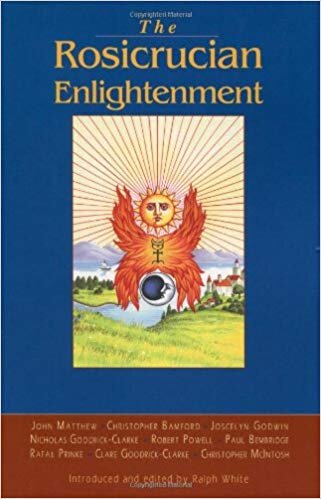
The Rosicrucian Enlightenment Revisited
Edited by John Matthews
Lindisfarne Books, 1999
267 Pages, $19.95
ISBN-10: 0940262843
“In suggesting that we regard the Cromwellian era in English history as a Rosicrucian episode, I do not intend to conjure visions of hooded figures seizing the ship of state like occult pirates and using it for their own cloudy, ritualistic ends. Rather, we should remove the Gothic filters that have marginalized this word over the centuries and see seventeenth-century Rosicrucianism for what perhaps it more nearly was – something far more sensational, a bursting forth of the age-old esoteric tradition in a political and cultural expression, a foamy glimpse of the great white whale that many a Captain Ahab has hunted through many a surging sea with far less chance of spearing than here.”
---The Rosicrucian Resurgence at the Courtt of Cromwell
Revisionist history does not get any merrier than this. In his contribution to this anthology quoted above, Paul Bembridge may not altogether persuade us that the poet Andrew Marvell was a “Rosicrucian,” or indeed to share his suspicion that Milton was one also. However, we do learn that “Rosicrucian” was a term of abuse used by royalists in Restoration England against important figures of the Protectorate. What more could a reasonable man ask? Each of the other eight contributions has at least this sort of merit, and often much more.
The book is an extension and reconsideration of Dame Frances Yates’s groundbreaking study, The Rosicrucian Enlightenment (1972), which argued that an important predicate to the emergence of scientific, secular modernity was the flowering in the late 16th and early 17th centuries of a millenarian hermetic movement based in England and Bohemia. As we learn in the Introduction by Ralph White, the book arose from two international conferences held in the Czech Republic, one held in 1995 in the town of Cesky Krumlov and dedicated specifically to assessing Dame Yates’s work, and the other at Prague in 1997 on “Prague, Alchemy, and the Hermetic Tradition.” That conference was part of a summer festival to commemorate the life and times of the alchemical Holy Roman Emperor, Rudolf II (1576-1612), who made Prague his capital. (This volume prefers “Rudolf” to “Rudolph,” and I will not quarrel with it.) A high time seems to have been had by all on both occasions.
For a full account of the thesis and particulars of The Rosicrucian Enlightenment, readers may turn to this review. Here are some impressionistic remarks about the contributions to this volume (other than by Bembridge, with whom we began):
John Matthews, in “The Grail and the Rose,” attempts to link the legends of the Holy Grail with the (admittedly imaginary) history of the Fraternity of the Rosy Cross. He does show some parallels between some versions of the Grail story and the key Rosicrucian texts, notably with The Alchemical Wedding of Christian Rosenkreuz. We are treated to a brief history of rose imagery during the High Middle Ages. Still, I think it is hard to argue that Rosicrucianism is simply the Grail Quest conducted by other means. For that matter, it is not at all clear that the Grail Quest was ever anything more than a literary conceit until relatively modern times. The important connection is probably that later alchemists took up Grail imagery and their alchemy had been modified by the Rosicrucian synthesis.
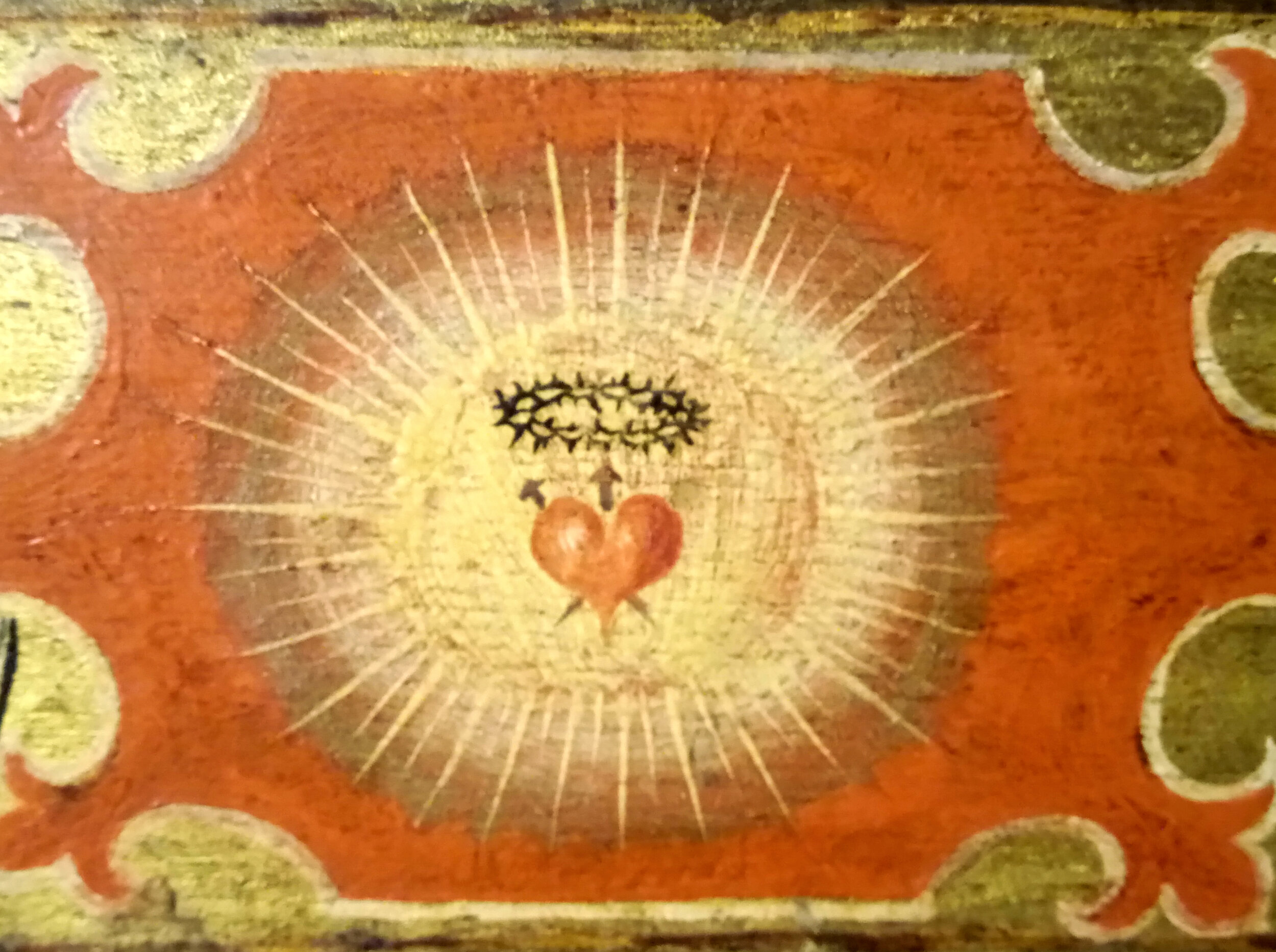
The Sacred Heart of Jesus
By Châtillon - Own work, CC BY-SA 4.0, https://commons.wikimedia.org/w/index.php?curid=67536152
In “The Meaning of the Rose Cross,” Christopher Bamford highlights the (quite real) connections between Rosicrucianism and medieval apocalyptic, and most especially with the eschatology of Joachim of Fiore. The Rosicrucians were waiting for the outpouring of the Holy Spirit in the final age that Joachim forecast. What made them important was their insistence that scientific research be among the reforms of the coming age. Bamford also suggests that the desire for this same outpouring of the spirit was the inspiration for the Catholic practice known as “The Devotion to the Sacred Heart” that appeared in France in the generation after the Rosicrucian moment in early 17th-century Germany.
Nicholas Goodrick-Clarke is best known for his sober studies of the role of the occult in the ideology of the Third Reich. His contribution to this book, “The Rosicrucian Prelude: John Dee’s Mission in Central Europe,” performs a similar function: he taps down some of the more extreme interpretations of what he nonetheless acknowledges to be an important historical juncture. Dame Yates had laid great stress on the fact that John Dee’s European itinerary in the 1580s had largely coincided with the scenes of the events leading up to the ill-fated reign of the Winter King and Queen of Bohemia in 1619. That marriage, between Elizabeth Stuart of England and Frederick V, the Palatine Protestant champion, was the event to which the Rosicrucian movement had looked to trigger the transformation of Europe (again: it was a movement, not a real secret society). Yates had suggested, not unreasonably, that Dee prepared the way for the Bohemian adventure ideologically and politically. Going over the record of what Dee actually did in Europe, however, Goodrick-Clarke does not find a man who seems to be chiefly concerned with esoteric politics. It is certainly true that Dee’s name and his personal hieroglyph, the Monas, appear prominently in Rosicrucian literature. However, the fact is that Dee’s views on the need to advance and unify knowledge along Hermetic lines were not new to the Prague of Rudolf II or to the continent in general.
Goodrick-Clarke does echo Yates in thinking that the Rudolphine episode represented a phase of tolerant, humanist universalism with both a Catholic and a Protestant face. This condition, he says, collapsed a generation later into the confessional, largely Protestant millenarianism known to us as Rosicrucianism.
Joscelyn Godwin, another noted authority on the intersection of politics and the occult, provides a study of “The Deepest of the Rosicrucians: Michael Maier (1569-1622).” Maier, like many prominent members of the Rosicrucian movement, was a physician in the tradition of Paracelsus and a practicing alchemist. Indeed, he at one point used alchemy to create the panacea, and thereby win favor at Rudolf’s court. He traveled to England to study hermeticism and to learn enough English to translate some famous texts (grumbling about English orthography all the while, it seems). He was present at the wedding of Frederick and Elizabeth, and he may have been a key link between Prague and Frederick’s capital at Heidelberg. He also did a great deal of work in what we would consider ordinary chemistry, as well as mining. If we may judge by this book, the compleat alchemist was likely to also be a mining engineer. He was a great systematizer of knowledge; to this this reviewer, at least, his ambition compares to that of the later encyclopedists. The difference, perhaps, is that they sought to dispel mystery, but Maier hoped to show that microcosm and macrocosm were united in a single great mystery.
He does seem to have lacked imagination in one regard, though. Maier was very explicit that the point of alchemy was not to become rich by producing gold. Alchemy was a spiritual enterprise; he was somewhat skeptical about whether the transmutation of elements was even possible. He apparently made statements to the effect that men would be corrupted by riches if gold were easily produced. Did it never occur to these people that if gold were as common as lead it would be no more valuable than lead?
And then we have “Tycho Brahe, Johannes Kepler, Rudolf II,” by Robert Powell. This contribution usefully places in their proper hermetic context the ambitions and techniques of the early modern astronomers. Historians of science place little importance on the fact that astrology funded the beginnings of astrophysics; they often also fail to appreciate that astronomy would not have happened without late Renaissance Platonism. (Brahe, by the way, was the scientist whose model of the solar system looked as if it had been designed by a committee: the planets orbit the sun, but the sun and moon orbit the Earth.) The piece is also interesting because the author takes the story back to Atlantis and Tibet, apparently without irony. The Hermetic Corpus is also referred to, without qualification, as “the Egyptian material.” We are given to understand that it contains a reference to heliocentrism, since the cosmos is called a “garland” around the sun.
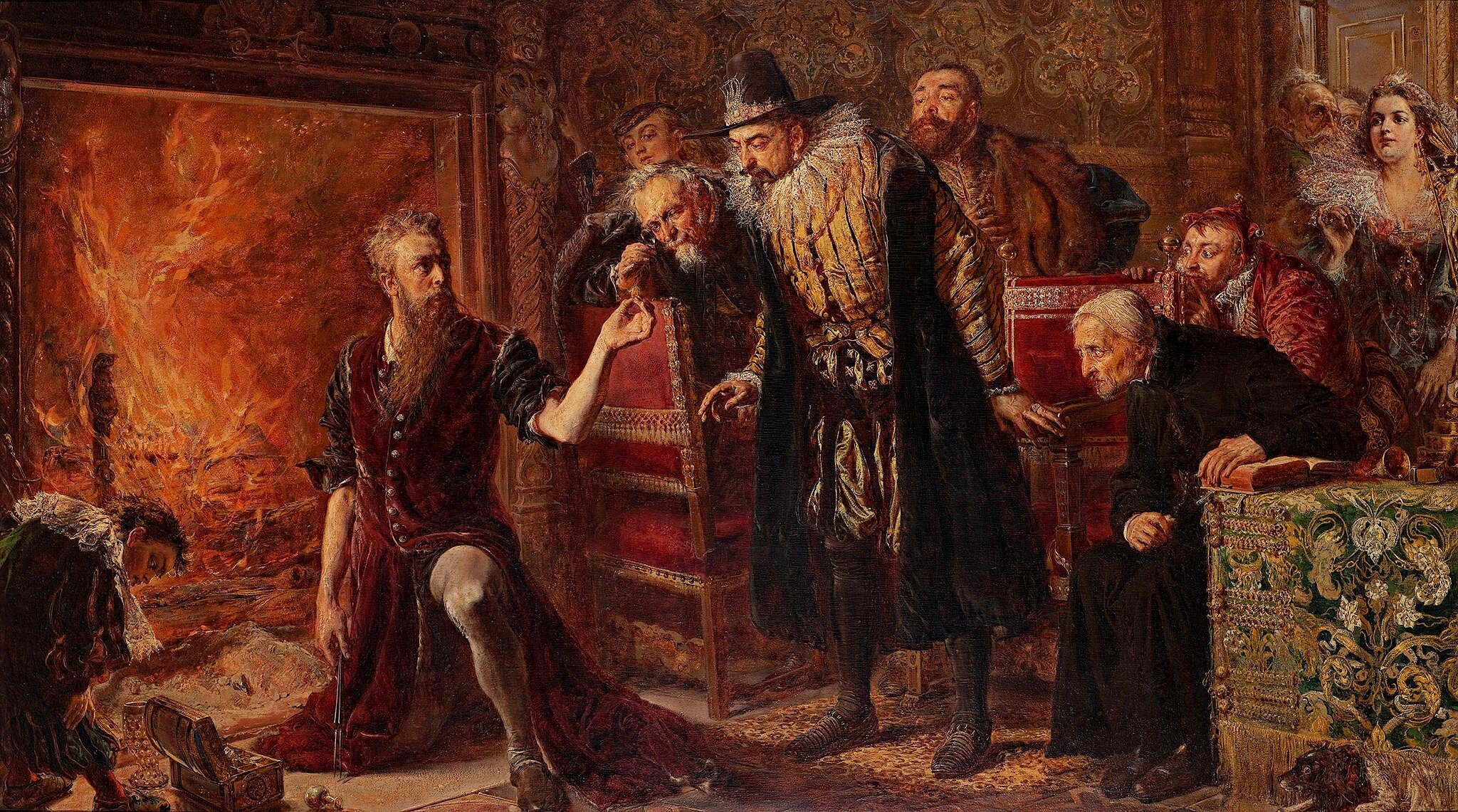
Michael Sendivogius
By Jan Matejko - pl.pinterest.com, Public Domain, https://commons.wikimedia.org/w/index.php?curid=67711
Rafal T. Prinke’s contribution, “The Twelfth Adept,” is a vindication of Michael Sendivogius (1566-1636), a famous alchemist of his day whom Michael Maier apparently designated as the “12th adept of the nations”: the others included people like Hermes Trismegistus and Thomas Aquinas. The problem was that Sendivogius, a prominent nobleman within both the Holy Roman Empire and the Kingdom of Poland, really did not want his name mentioned explicitly in some contexts, so Maier lightly encrypted his identity. The result was that later historians conflated his story with that of the Scottish alchemist, Alexander Seton, and with John Dee’s fishy spirit medium, John Kelley. Thus, biographies of him have tended to conflate his life with a conventional morality tale of the Alchemical Fraud. The phases of the Fraud’s life are: obscure origins; wealth by imposture; imprisonment and escape; death in poverty. None of these things seem to have been true of Sendivogius. One might note, however, that one of the difficulties with writing a more accurate biography of this man is that the accounts that Prinke finds most trustworthy are also the ones that mention the greatest number of successful alchemical transmutations.
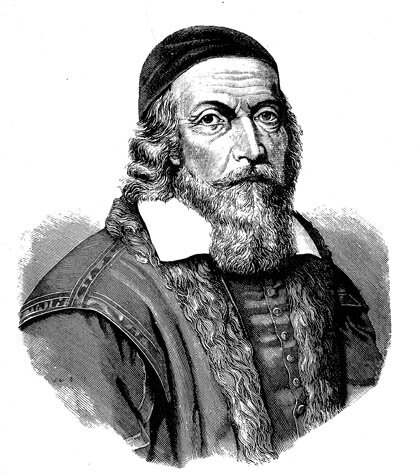
John Amos Comenius
Public Domain, https://commons.wikimedia.org/w/index.php?curid=1420696
Among the most interesting contributions is “The Rosicrucian Afterglow: The Life and Influence of Comenius,” by Clare Goodricke-Clarke (the wife of Nicholas). Jan Amos Comenius (Jan Ámos Komenský) (1592-1670) was a Bohemian priest of the Moravian Brethren who saw the ruin of his country after the defeat of the Winter King and Queen, but before that was in close contact with key Rosicrucians in Germany. Later, he lived in Sweden and, most significantly, in England. Comenius is, in fact, the Anglo-Bohemian Connection incarnate. H. R. Trevor-Roper named him, along with Samuel Hartlib and John Dury, as one of the “Three Foreigners” whose millenarian reformism provided the ideology for Cromwell’s Commonwealth. He was another hermetic polymath: his version of universal knowledge was called pansophism. He is chiefly remembered for two things: for his educational reforms (he is credited with getting practical subjects into the school curriculum), and for his interest in organizing a real “invisible college” for the advancement of knowledge, an interest that almost certainly influenced the creation of the Royal Society.
Finally, “The Rosicrucian Legacy” by Christopher McIntosh tries to relate the real Rosicrucians of the 17th century, who knew perfectly well that there was no “Fraternity of the Rosy Cross,” or at least who understood that they did not belong to it, with the later organizations that have claimed the name “Rosicrucian.” The Masons claimed Rosicrucian connections early in their history, and there was no doubt overlap in ideology and personnel between them and the people who were “Rosicrucians” in Frances Yates’s sense. Among the “secret societies,” perhaps the most important was the Golden and Rosy Cross of Germany. Very influential in the 18th century, it may have belied the reputation of Enlightenment hermetic societies by being, not a nest of Jacobins, but a league of political reactionaries. Some redaction of its rules and rituals seems to have formed the basis of the famous Order of the Golden Dawn in England, though the system cultivated by that group was in large part an original synthesis.
Does all this change our view of history? If you believe some of these contributors, we must now understand the 17th-century wars of religion as a conflict between Christian orthodoxy and Gnosticism, or at least between Catholicism and an esoteric Christianity in the same tradition as Catharism. (And this would apply not just to Europe: Massachusetts Governor John Winthrop invited Comenius to come to America and head the recently founded Harvard College.) I think perhaps that interpretation is a bridge too far, but the material in this book will tempt readers never look at a Puritan in quite the same way again.
As for Rosicrucianism pure and simple, perhaps it is idle to trace its lineage down the back alleys and byways of intellectual history. To some degree, the Rosicrucian millennium is all about you.
Support the Long View re-posting project by downloading Brave browser. With Both Hands is a verified Brave publisher, you can leave me a tip too!
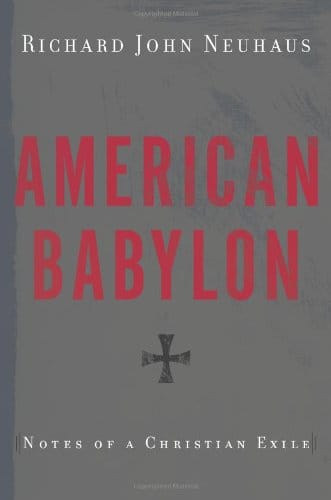
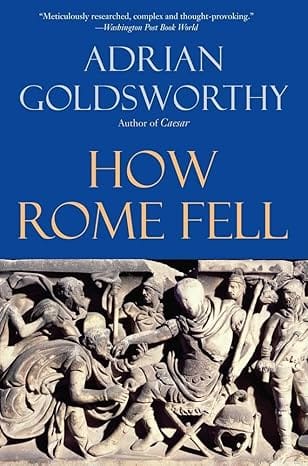
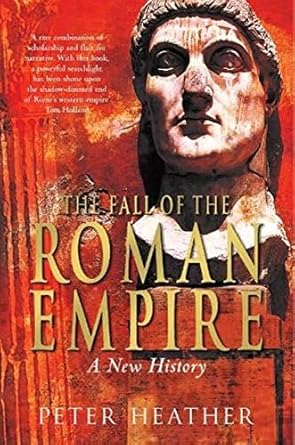
Comments ()